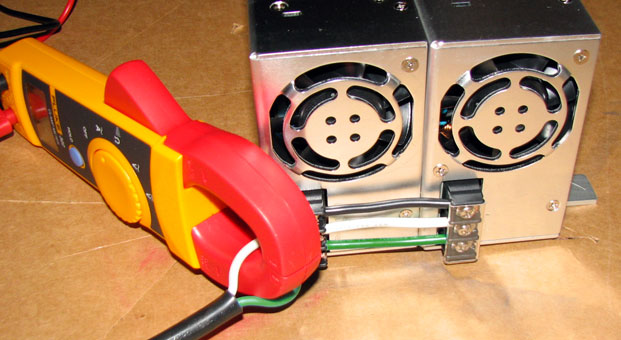NeilP
1 GW
No, those are no use at all. They are AC out, not DC
(edit: OK, purchased a 48V 7.3A 350W MW, or what seems to be a rather good meanwell clone from an ebay vender called e_lightning, I can't find that ebay vendor anymore, but these can occasionally be found for under $50).
I swapped out the TH1 thermal resistor that controls the fan and I installed a 1000ohm 1/4w resistor. This keeps the fan always running... but the fans speed is in direct relation to the voltage you are running the supply at. Lower the voltage the lower the speed. The Higher the Voltage the Higher the Speed.
I replaced the svr1 which is right by the LED and output with a blue 10k 15turn trim pot. This will allow you to tune to around 17-18v up to 56-58v with great precision.
I removed and replace r37 and r33 with two 1200ohm resistors on top of the board and I paralleled another 2200ohm resistor across those two on the bottom of the board. I used 1/2w but thats what I had. It supposed to come out to 470ohm but there is something else in the circuit thats dropping it down to an even 400ohms when I check it with my Vm. Everyone else seems to put a trimp pot across r33/r37. The higher the value the higher the current limit is. It almost seems linear to wattage. Again I was using the resistors I had avaliable.
So probably in short to make it simple for you remove r33 and r37 and drop 500 and 1200 ohm resistor. This higher value will probably reduce your output wattage a bit to around 300-350w but i will also put it in a safer operating range close to the rating of the power supply.
With these 3 mods in my configuration its locked in at around 10A.

Kingfish said:The Amp Meter that I use for some reason will not measure DC amps, which I admit is odd. If you know of a device that can do it, I’m all ears friend
Kingfish said:The meter I have now is a Fluke Corporation 322 AC Clamp Meter; it does not measure DC current - although I thought it did when I bought it. Sadly a decent DC clamp meter begins around $330 USD; 3X the cost of my 322-unit. It's not a hi-pri right now.
Kingfish said:color=#400080]Neil[/color], yer on yer own to figure it out with the data that I've provided :wink:
Hillhater said:$25 HK Wattmeter will tell you all you need to know on charging, Max -min Volts, amps, watts, Ahrs, Whrs etc etc
Kingfish said:Ah Neil -
Now if only we could parallel them
Kingfish said:I think what we need to do is branch this thread and begin anew to build/source a good 100VDC/100A Watt meter. Whatcha think?
Good job, KF
I would ask fechter directly as I do not have that information. I personally do not use the SP units anymore; maybe I should sell them off.geetarboy said:Does the 'mini meanwell limiter board' solve the problem on the meanwell 'SP' model to handle CC ? Thanks
geetarboy said:Does the 'mini meanwell limiter board' solve the problem on the meanwell 'SP' model to handle CC ? Thanks
EVInfinity wrote: Here is the link, enjoy...
